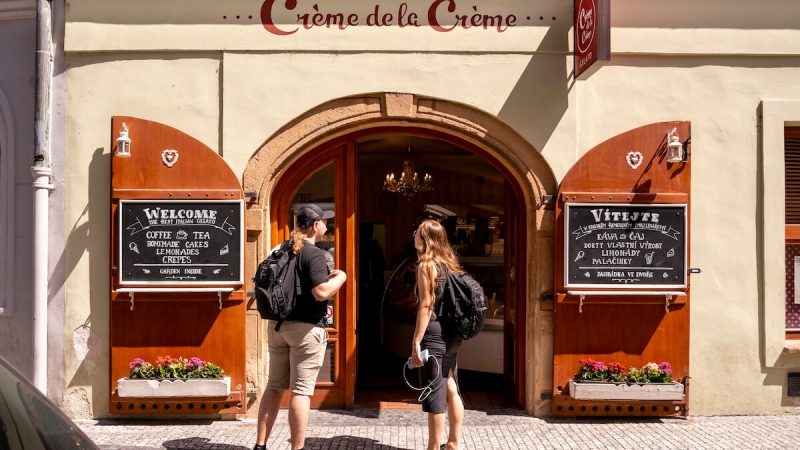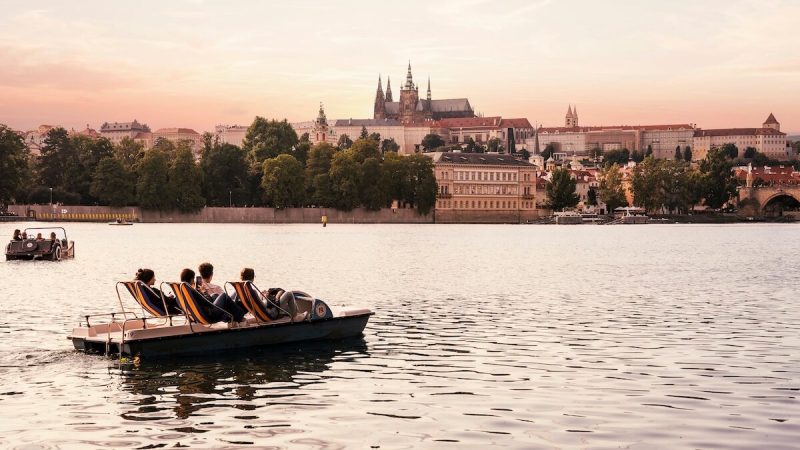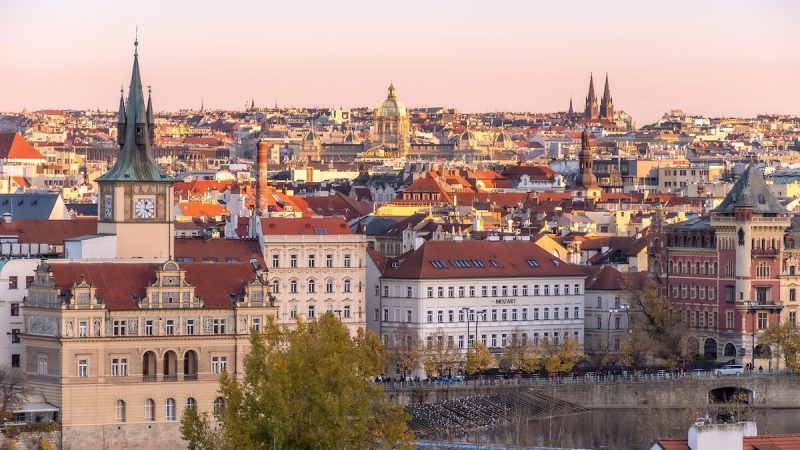A local’s guide to Prague: Practical tips for your memorable trip 2025

You want to go to Prague to enjoy what it has to offer to the fullest, right? So let me as a local cover a few practical tips for you that you should know so you can spend your time exploring Prague’s beauty without having to worry about these things.
Let’s take a look at things you should know before actually going to Prague, such as when to go to Prague, how to get to Prague, where to stay in Prague, if you should exchange money ahead of time if you need a visa etc.
Then we’ll continue with practical tips to know when you are in Prague such as how to get from the Prague airport, how to get around Prague, which mobile apps will be useful for your stay in Prague and so much more.
So here it is, let’s dive into it.
Everything you need to know before visiting Prague
Are you planning your trip to Prague? Good for you! You won’t be sorry. But before you go, make sure you’ve covered and considered everything listed below.
How to get to Prague
Prague, the Czech Republic’s capital, is located right in the heart of Europe. You can reach Prague either by plane, train, bus, or, of course, car. Find a brief overview below or check out the detailed article How to get to Prague: The best options to reach the Czech capital.
For those flying into the city, the modern international airport Vaclav Havel Airport Prague (PRG) is located just a short distance northwest of the city centre. Many major airlines offer flights to Prague from cities around the world, making it easy to plan your trip. To find the best route options and cheap flights to Prague from your location, check SkyScanner or Kiwi.com.
If you prefer to travel by train, Prague Main Train Station is located right in the city centre. There are direct trains to Prague from many major European cities, so it’s easy to plan your journey by rail. For international travel, you can use the Czech National Railways České dráhy or private railways RegioJet (my favourite) or Leo Express. The best way to check your train connections and routes are Omio.com or Trainline.com. Check IDOS.cz/en for international and all local train connections.
Another option is taking a bus to Prague. Several international bus lines connect Prague to other European cities. FlixBus and RegioJet are popular coach carriers. The best place to check your bus connections and routes is Omio.com. Are you looking for a combination of train and bus? Check IDOS.cz/en. The Florenc bus station, where most international buses or coaches terminate, is also close to the city centre and is well-served by public transportation.
Alternatively, you can even drive to Prague by car. To use Czech highways, you need to first obtain an electronic vignette from the official website edalnice.cz/en. There are no low-emission zones in Prague, so you can enter the city and the city centre without restrictions. However, the majority of Prague has paid parking zones, so you will need to plan for parking.
Learn more about how to get to Prague in the detailed article How to get to Prague: The best options to reach the Czech capital.
Accommodation in Prague
Of course, there are numerous accommodation options in Prague depending on your preferences – location, budget, and so on. So let’s start with the location! If you wish to stay right in the city centre, within walking distance of the historical centre, check Malá Strana (The Lesser Quarter) or Staré město (The Old Town City). However, expect these areas to be very busy and crowded. Try Letná district, Karlín, Vinohrady, Dejvice, Bubeneč, or Holešovice if you prefer something more calm and local but still close to the centre.
I’ve picked up several hotels, hostels and Airbnb’s that I recommend. So here are a few tips:
budget hostel: Plus Prague Hostel in Holešovice with swimming pool (night for €9)
design hotel: Hotel Josef in the Old Town (night for €130)
apartment with a view: Pretty Woman studio (2 nights for €280)
unconventional stay: Houseboat on the Vltava river with Vyšehrad castle view (2 nights for €180)
unique stay: One Room Hotel 70-meter-high room in the Žižkov Television Tower (night for €550 on weekdays, €850 on weekend days)
How many days do you need in Prague?
If you’re planning your Prague trip and aren’t sure how long you should stay, I’d recommend staying for at least 3 or 4 days (2 or 3 nights). Of course, if Prague is a stopover destination or you are in a hurry for any other reason, you can enjoy the top Prague attractions in less time.
But make sure you come back for more! 3 to 4 days is ideal to allow enough time to explore the main attractions without feeling rushed. But you can stay for a week or two and still have plenty of things to see and do.
Weather in Prague and the best time to visit
If it was up to me, I would visit Prague in the spring or autumn, as these are my favourite seasons for exploring the city. There are many parks and trees that make Prague more beautiful when they bloom in the spring and when they turn into beautiful autumn palette colours.
Spring and autumn have the most pleasant weather because it is neither too hot nor too cold. Summer temperatures can reach 30 degrees Celsius (86°F), while winter temperatures can reach 0°C (32°F), but can also drop lower. But! Prague covered in snow is stunning. You can even cross-country ski in Prague. So there is literally nothing that can stop you from enjoying Prague all year.
National Holidays in the Czech Republic
I always forget to check the dates of national holidays in the country I’m visiting, and sometimes I’m very surprised. Are you guilty of this too? Well, here you are. You’re welcome.
Czech National Holidays in 2025
- 1 January – Restoration Day of the Independent Czech State, New Year’s Day
- 18 April – Good Friday (flexible date)
- 21 April – Easter Monday (flexible date)
- 1 May – Labour Day
- 8 May – Liberation Day
- 5 July – Saint Cyril and Methodius Day
- 6 July – Burning at Stake of Jan Hus
- 28 September – St. Wenceslas Day, Statehood Day
- 28 October – Independent Czechoslovak State Day (created in 1918)
- 17 November – Struggle for Freedom and Democracy Day
- 24 December – Christmas Eve
- 25 December – Christmas Day
- 26 December – 2nd Day of Christmas
Prague attractions are usually open during national holidays, but some museums and galleries may be closed or have different hours than usual. When it comes to the opening hours of shops, there are two “types” of national holidays. Large stores above 200 square metres are required by law to close on the following dates:
- 1 January
- 10 April
- 8 May
- 28 September
- 28 October
- 24 December (shops are open in the morning, closing at noon at the latest)
- 25–26 December
For the rest of the national holidays, it might be open (and usually is), but it depends on the owner.
Travel Insurance
When travelling abroad, always have your travel insurance with you! It is a must-have thing for travellers, and you should never leave your country without it, as it can save you a lot of trouble. Check World Nomads, the popluar choice of travelers.
Czech Currency
We have Czech crowns (CZK) in the Czech Republic because we are not a member of the eurozone despite being a member of the European Union. You don’t really need to exchange your money in advance.
You can pay with your card almost everywhere. If you need cash, you can get Czech crowns from an ATM. However, if possible, avoid using Euronet ATMs because they will try to trick you into paying far more than necessary. It is safer to use ATMs from Czech banks such as Česká spořitelna (Erste Group), Komerční banka or KB (Société Générale), Fio Banka, AirBank, ČSOB, UniCredit Bank, Raiffeisen Bank, Equa bank, or Moneta.
If this is not an option for you due to bank fees, you can use an exchange office in Prague. However, be aware that some can give you a very poor exchange rate. From personal experience, I recommend EXCHANGE on Kaprova street, close to the Old Town Square (where the astronomical clocks are).
Never ever exchange cash on the street (even if it is in front of an exchange office, that is actually an even bigger red flag). Always keep a transaction receipt and keep in mind that you have the legal right to return the transaction within three hours. If you fall victim to a trap or a scam, call municipal police 156.
Car Rental
I don’t think you’ll need a car in Prague; you can just walk or take public transportation for longer distances. However, if you absolutely must have a car for your whole stay, you should book it in advance for better rates. For the best deals, go to rentalscars.com. Remember that if you rent a car, you will most likely have to deal with parking (check the paragraph above about arriving in Prague with a car).
You can use car-sharing services such as Anytime (which I love and use all the time), Bolt Drive (so you can either order Bolt as a taxi, or rent their cars), or Car4way for short-term rentals in terms of minutes, hours, and days. The fact that you don’t have to worry about parking is a huge benefit of car-sharing, but it depends on the terms of the specific company.
Practical tips when you’re in Prague
Are you already in Prague? Hurray! Let’s look at some tips that might be useful to you during your visit to Prague.
At the Prague airport
Václav Havel Airport Prague has two main terminals: T1 for intercontinental and non-Schengen flights (so US, Canada, UK, Australia, Asia…) and T2 for European flights within the Schengen area. Both terminals are approximately 5 minute’s walk apart through the airport building. So you don’t have to worry about missing your flight if you arrive at the wrong terminal on your way home.
Prague Airport’s official website is prg.aero, where you can check arrivals, departures, and flight status. I recommend that you sign up for their useful SMS notifications about your flight. I’ve covered this topic in detail in the article How to get to Prague – the best options to reach the Czech capital.
How to get from the Prague airport to the city centre
If you fly into Prague, you will land at Václav Havel Airport Prague in the Ruzyně district (northwestern edge of Prague). Public transportation is the best way to get to the city centre because it is fast, cheap, and runs every few minutes. Taking trolley-bus 59 to the green line A metro stop Nádraží Veleslavín is the quickest option. Then you’ll be in the city centre in a few minutes’ metro ride.
You can also take a taxi, with the official airport taxis being right now being Uber, or Bolt. Beginning spring of 2023, Uber is the only official airport taxi. You can order it via Uber mobile app, or you can find self-service kiosks and Uber service counter at the airport.
I’d recommend not to use services of “taxi companies” actively approaching you after your arrival. These are better to be avoid, if you don’t want to be scammed.
Find more information in my article The Best Way to Get Around Prague.
How to get from the main train station and bus station
The main train station in Prague is called “Praha hl.n.” or “Hlavní nádraží” and is located near the city centre. It is served by the metro line C stop “Hlavní nádraží” as well as trams and buses.
The Florenc bus station, where most of the international buses or coaches terminate, is also close to the city centre and well-served by public transportation. There are two metro lines, the yellow line B and the red line C, trams and buses. Check my article The Best Way to Get Around Prague for more info.
How to get around Prague
I highly suggest using Prague public transportation because it is really reliable, cheap, fast, clean… Everything you really need. You can choose from trams, metro, buses, and trains, as well as historical trams, ferries, and funiculars for more adventurous rides.
My other favourite option is to use the bike-sharing platforms Rekola (which I love because it’s local and pink) or NextBike. If you really need to, there are Lime scooters available, but please don’t. It’s not safe to ride them on a street (which is where you should ride them), nor on pedestrian walkways.
You can get a taxi ride using Uber, Bolt, or try Liftago, a local app that lets you choose a driver according to his or her rating, price etc.
If you want to drive on your own, for short and mid-term leases you can use car-sharing services such as Anytime (I use it very often and just love it), Bolt Drive, or Car4way or for mid and long-term you can rent a car – check out the options on rentalscars.com.
However, the majority of the city can be explored by simply walking. Everything in the city centre is pretty close and easy to reach on foot. You can discover so much more when you explore the city on foot! Beautiful houses in tiny streets, hidden cosy cafés, old statues or modern street art, and so much more.
Moreover, it is good to know that as a pedestrian, you have priority at the pedestrian crossing, and a car driver must stop and give you the right of way. However, even at crossings, trams have priority over pedestrians.
Another useful tip is that the last metro runs around midnight. After midnight, you can take night trams and buses. For more information, see The Best Way to Get Around Prague.
Tap water and public fountains with drinking water
Tap water is perfectly safe to drink in Prague, and it actually tastes good, so don’t be afraid to drink it, and don’t buy bottled water. That saves your money and also the environment. Win-win situation. Moreover, you can bring your bottle and refill it at many public fountains with drinking water in Prague. A map of them is at mapy.cz/en. If you have Mapy.cz mobile app as I recommend below, just type and search for “drinking water”. Cheers.
If you’re in need of bottled water the bottle with natural water is marked with blue and says “neperlivá”, slightly sparkling water is green and called “jemně perlivá” and sparkling water is red “perlivá”.
Public toilets
A public toilet can usually be found in metro station lobbies, train stations, commercial centres, and so on. The Mapy.cz mobile app is also an excellent source for locating a public toilet near you. Search for “public toilet” within the app or at the online map mapy.cz/en. Some are paid (usually 10 to 20 CZK, which is less than €1), while others are free. The opening hours are limited.
Drinking alcohol and smoking in public in Prague
Speaking of public places, it might be also useful to know that in some places it’s illegal to drink alcohol in public. So you won’t get in trouble. Because, you know, ignorance of the law is not an excuse. It is forbidden to drink alcoholic beverages in over 800 designated public places. Metro stations, schools, playgrounds, public transportation stops, healthcare facilities, commercial centres, parks, and Prague islands are some examples. You can see the locations marked on a map here.
When it comes to smoking, it is not allowed to smoke in restaurants, cafés, bars and any other indoor places. You can usually smoke in a restaurant or café’s outdoor seating area. It is also prohibited to smoke at public transportation stops.
Tipping
If you were pleased with a service (restaurant, bar, café, taxi, etc.), it is common in the Czech Republic to leave a tip. We usually just round the amount up or leave a tip around 10 to 20% of the bill amount, according how satisfied we were.
Shopping, groceries, cosmetics
If you need to buy groceries, there are supermarkets such as Lidl, Billa, Albert, and Tesco, as well as hypermarkets such as Globus, Kaufland, and Tesco. Small grocery stores named Žabka can be found in the city centre.
Look for cosmetics at drugstores such as dm drogerie, Rossmann, and Teta Drogerie. Shops are usually open every day until 9 or 10 p.m. (depending on the location). Billa supermarkets can also be found at the airport and the main train station.
Medical Emergency, Emergency pharmacies
If you need to call an emergency service, dial emergency number 112 for all parts of the integrated rescue system (police, firefighters and paramedics). The operators speak several languages (English for sure). Calling 112 does not require a SIM card or credit.
If you only require one specific service, you can also dial:
- 150 for firefighters
- 155 for paramedics
- 158 for state police
- 156 for municipal police
If something happens to you and you need a medical emergency but don’t need an ambulance, you can reach the special foreigners’ department at Motol University Hospital. Large Prague hospitals also have an emergency department; depending on your location, you can reach these emergencies for adults as well as children:
- Motol University Hospital (Fakultní nemocnice v Motole)
- Military University Hospital (Ústřední vojenská nemocnice)
- Thomayer Hospital (Thomayerova nemocnice)
- Bulovka Hospital (Nemocnice na Bulovce)
- Vinohrady Hospital (Fakultní nemocnice Královské Vinohrady)
Teeth can hurt a lot, so if you need to see a dentist right away, check out these dentist emergencies:
Adult dental emergency service:
- Municipal Health Centre Prague (Městská poliklinika Praha)
- Thomayer Hospital (Thomayerova nemocnice)
Dental emergency service for children and adolescents up to 18 years:
- University Hospital Motol (Fakultní nemocnice v Motole)
In Prague, there are several 24-hour or late-night emergency pharmacies. For example, most large Prague hospitals have one. You can find them marked on a map alongside the other medical emergencies mentioned above.
Luggage storage
Do you need to get rid of your suitcase or backpack so you can go exploring the city? You can store your luggage at the airport (in Terminal 2 departures hall) as well as in the city centre at Main Railway Station, Masaryk Railway Station, and Florenc Coach Station or you can use private services such as:
EasyLocker Prokopská 625/3, Prague 1
Luggage Storage Havlíčkova 2, Prague 1 and Olivova 7, Praha 1
Luggage Prague Haštalská 12, Prague 1
Shopping malls in the city centre like Palladium, Quadrio, Nový Smíchov and Flora do not have luggage storage. Self-service lockers are available at shopping malls Galerie Harfa, Metropole Zličín and Centrum Černý Most.
SIM cards and mobile data in Prague
If you are an EU citizen, you should be fine with your home mobile and data tariff. If this is not your case or you simply need more data, you can check these offers from local providers, including Vodafone, O2, T-Mobile and several smaller ones. The following are the best mobile data deals from the biggest providers:
Vodafone 15 GB for 499 CZK (€20)
T-Mobile 10 GB for 200 CZK (€8) or 15 GB for 299 CZK (€12)
O2 100 GB for 449 CZK (€18) or 3 GB for 299 CZK (€13)
So you can choose what works best for you based on your data usage. If you arrive at Prague Airport, the simplest option is to purchase a SIM card from Vodafone, which has a branch in Terminal 2. There is a machine that runs 24/7.
You can also consider using eSIM card e.g. by Revolut. It’s easy and convenient.
That’s all, folks!
I hope you found some useful information here to help you with your trip to Prague. Is there anything else you want to know? Please leave it in the comments section. Have a wonderful time in Prague!




